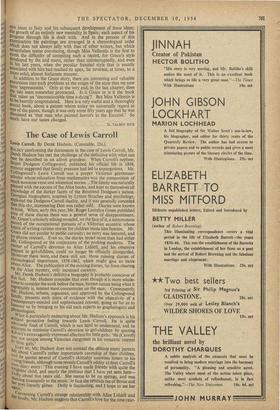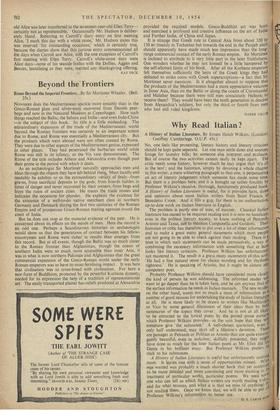The Case of Lewis Carroll
Lewis Carroll. By Derek Hudson. (Constable. 21s.)
touxv confronting the documents in the case of Lewis Carroll, Mr. berek Hudson has met the challenge of the definitive with what can best be described as an adroit grandeur. When Carroll's nephew, Stuart Dodgson Collingwood, published his official life in 1898, rumour suggested that family pressure had led to expurgations. Mr. Collingwood's Lewis Carroll was a proper Victorian gentleman, scholar whose relaxation from mathematics was the composition of Much nonsense verse and whimsical stories. —The family was naturally Pleased with the success of the Alice books, and kept to themselves all Knowledge of the darker facets of the Reverend Dodgson's nature. Georgian biographers, inspired by Lytton Strachey and psychology, explored the Dodgson-Carroll duality, and it was generally conceded that this shy, stammering Don was rather odd. Diaries were known to exist. When, early this year, Mr. Roger Lancelyn Green published nine of those diaries there was a general sense of disappointment. Mr. Green's scholarly editing revealed, on the face of it, a monotonous ,record of the occupational pursuits of a Victorian eccentric whose Knack of writing curious stories for children made him famous. Mr. Green did not pander to public curiosity; no entry was featured, and 11,0 phrase stressed. Even so, the diaries reveal more than had either mr. Collingwood or the conjectures of the probing moderns. The Matter of Carroll's devotion to Alice Liddell, and his obsessive Interest in girl-children, could no longer be officially disregarded. Moreover there were, and there still are, those missing diaries of chronological importance, 1858-1862, which might give us more about Alice. The publication of the existing diaries, far from clearing uP the Alice mystery, only increased curiosity. Mr. Derek Hudson's definitive biography is probably conscious of this fact. Mr. Hudson concedes that even though it is more whole- some to consider the work before the man, human nature being what it r,e.grettably is, interest most concentrates on the man. Consequently r4r. Hudson, urbane, sagacious, and approved by the Collingwood _1114, presents each piece of evidence with the objectivity of a tiontemporary-minded and sophisticated counsel, going so far as to n._11, 'flour us by bringing to his aid such experts as graphologists and vnrenologists.
What is particularly endearing about Mr. Hudson's approach is his evident protective feeling towards Lewis Carroll. He is quite
Oviously fond of Carroll, which is not hard to understand, and he tl,ttempts to minimise Carroll's devotion to girl-children by quoting i‘ilvert's extravagantly expressed affection for little girls: 'He [Carroll]
not unique among Victorian clergymen in his romantic interest III little girls.' old Alice was later transferred to the seventeen-year-old Ellen Terry— certainly not as reprehensible. Occasionally Mr. Hudson is deliber- ately bland. Referring to Carroll's' diary entry on first meeting Alice, '1 mark this day with a white stone,' Mr. Hudson states this was reserved 'for outstanding occasions,' which is certainly true, because the diaries show that this curious entry commemorated all tht days when Carroll saw Alice, with the one exception of Carroll's first meeting with Ellen Terry. Carroll's white-stone days were Alice days—none of his seaside frolics with the Dollies, Aggies and Bessies, tantalising as they were, merited any thanksgiving offering.
KAY DICK









































 Previous page
Previous page